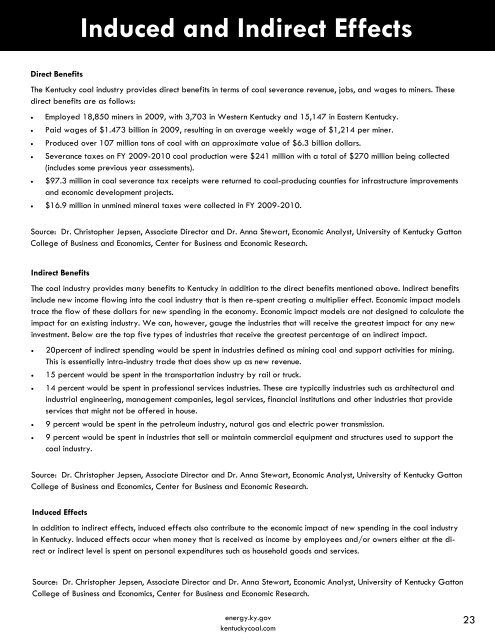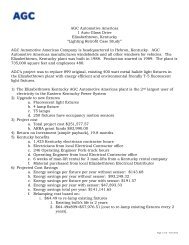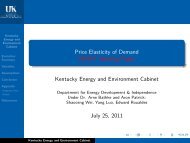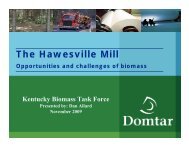Kentucky Coal Facts - 13th Edition - Department for Energy ...
Kentucky Coal Facts - 13th Edition - Department for Energy ...
Kentucky Coal Facts - 13th Edition - Department for Energy ...
Create successful ePaper yourself
Turn your PDF publications into a flip-book with our unique Google optimized e-Paper software.
Induced and Indirect Effects<br />
Direct Benefits<br />
The <strong>Kentucky</strong> coal industry provides direct benefits in terms of coal severance revenue, jobs, and wages to miners. These<br />
direct benefits are as follows:<br />
<br />
<br />
<br />
<br />
<br />
Employed 18,850 miners in 2009, with 3,703 in Western <strong>Kentucky</strong> and 15,147 in Eastern <strong>Kentucky</strong>.<br />
Paid wages of $1.473 billion in 2009, resulting in an average weekly wage of $1,214 per miner.<br />
Produced over 107 million tons of coal with an approximate value of $6.3 billion dollars.<br />
Severance taxes on FY 2009-2010 coal production were $241 million with a total of $270 million being collected<br />
(includes some previous year assessments).<br />
$97.3 million in coal severance tax receipts were returned to coal-producing counties <strong>for</strong> infrastructure improvements<br />
and economic development projects.<br />
$16.9 million in unmined mineral taxes were collected in FY 2009-2010.<br />
Source: Dr. Christopher Jepsen, Associate Director and Dr. Anna Stewart, Economic Analyst, University of <strong>Kentucky</strong> Gatton<br />
College of Business and Economics, Center <strong>for</strong> Business and Economic Research.<br />
Indirect Benefits<br />
The coal industry provides many benefits to <strong>Kentucky</strong> in addition to the direct benefits mentioned above. Indirect benefits<br />
include new income flowing into the coal industry that is then re-spent creating a multiplier effect. Economic impact models<br />
trace the flow of these dollars <strong>for</strong> new spending in the economy. Economic impact models are not designed to calculate the<br />
impact <strong>for</strong> an existing industry. We can, however, gauge the industries that will receive the greatest impact <strong>for</strong> any new<br />
investment. Below are the top five types of industries that receive the greatest percentage of an indirect impact.<br />
<br />
<br />
<br />
<br />
<br />
20percent of indirect spending would be spent in industries defined as mining coal and support activities <strong>for</strong> mining.<br />
This is essentially intra-industry trade that does show up as new revenue.<br />
15 percent would be spent in the transportation industry by rail or truck.<br />
14 percent would be spent in professional services industries. These are typically industries such as architectural and<br />
industrial engineering, management companies, legal services, financial institutions and other industries that provide<br />
services that might not be offered in house.<br />
9 percent would be spent in the petroleum industry, natural gas and electric power transmission.<br />
9 percent would be spent in industries that sell or maintain commercial equipment and structures used to support the<br />
coal industry.<br />
Source: Dr. Christopher Jepsen, Associate Director and Dr. Anna Stewart, Economic Analyst, University of <strong>Kentucky</strong> Gatton<br />
College of Business and Economics, Center <strong>for</strong> Business and Economic Research.<br />
Induced Effects<br />
In addition to indirect effects, induced effects also contribute to the economic impact of new spending in the coal industry<br />
in <strong>Kentucky</strong>. Induced effects occur when money that is received as income by employees and/or owners either at the direct<br />
or indirect level is spent on personal expenditures such as household goods and services.<br />
Source: Dr. Christopher Jepsen, Associate Director and Dr. Anna Stewart, Economic Analyst, University of <strong>Kentucky</strong> Gatton<br />
College of Business and Economics, Center <strong>for</strong> Business and Economic Research.<br />
energy.ky.gov<br />
kentuckycoal.com<br />
23

















